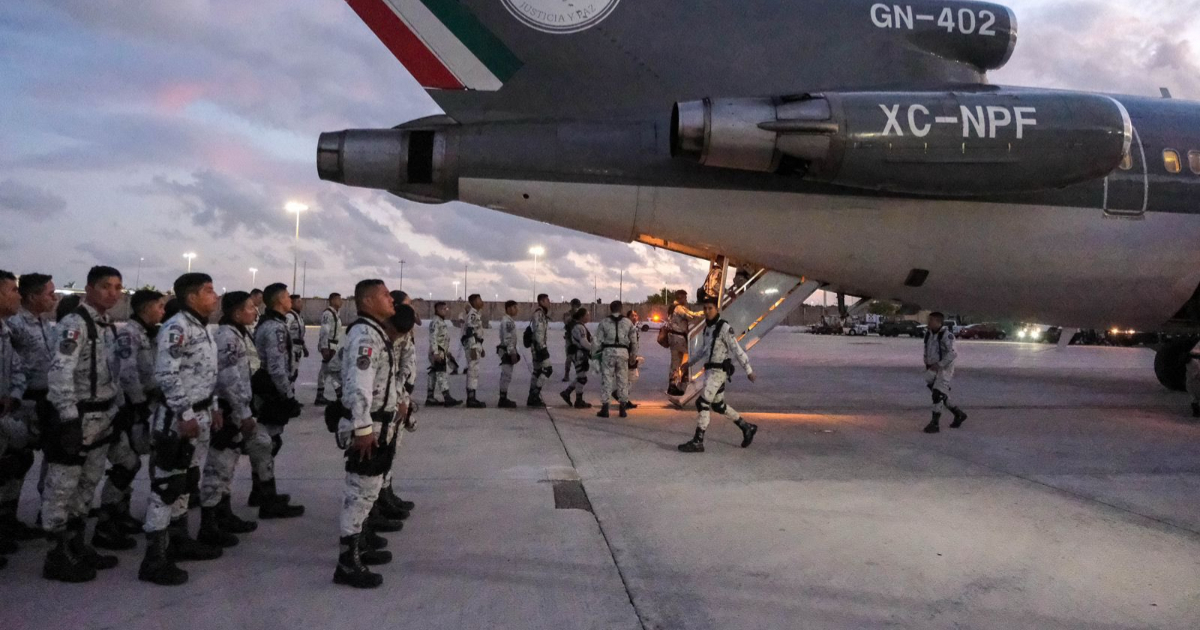
Related videos:
The government of Mexico has begun the deployment of 10,000 members of the National Guard at the border with the United States, aiming to curb irregular migration and combat human and drug trafficking.
This measure is the result of an agreement reached between President Claudia Sheinbaum and U.S. President Donald Trump, following a phone conversation in which they decided to suspend the imposition of a 25% tariff on Mexican exports for one month.
According to Mexican journalist Michelle Rivera, the Secretariat of National Defense (SEDENA) announced the start of the "Northern Border Operation", which involves the deployment of 10,000 members of the National Guard and the Army at the Mexico-United States border.
The deployment will focus on the main illegal crossing points, including the borders of Tamaulipas, Coahuila, Chihuahua, and Baja California.
A total of 990 agents from the National Guard will be deployed there, using aircraft from the Mexican Air Force and the National Guard.
In addition, 6,310 agents are being deployed by land to locations such as Tijuana, Tecate, and Mexicali in Baja California; Agua Prieta and Sonoyta in Sonora; Piedras Negras and Ciudad Acuña in Coahuila; Ojinaga, Puerto Palomas, and Ciudad Juárez in Chihuahua; Colombia in Nuevo León; and Playa Bagdad and Ciudad Mier in Tamaulipas.
In addition, 2,700 personnel from military units from various states are heading to strategic points on the northern border.
The operations will include patrols, surveillance, and the establishment of checkpoints on key routes to disrupt human trafficking and drug trafficking networks.
For its part, the United States committed to working to stop the flow of high-powered weapons into Mexico.
According to CNN, President Sheinbaum, in her morning conference, emphasized that this action aims to maintain order and protect migrants from the risks they face during their journey.
He also emphasized the importance of bilateral cooperation to address common challenges in security and trade.
Experts in security and migration warn that without a comprehensive strategy addressing the structural causes of migration, containment measures may prove insufficient.
The military operation will continue indefinitely and will be evaluated periodically to determine its effectiveness in reducing human trafficking and irregular migration.
Pause in the imposition of tariffs by Trump on Mexico and Canada
After arriving at the White House on January 20, the President of the United States, Donald Trump, announced the imposition of a 25% tariff on imports from Mexico and Canada, and a 10% tariff on those from China, arguing that these countries had not taken adequate measures to stop the flow of fentanyl and illegal immigration into the United States.
This decision created trade and diplomatic tensions, as Mexico, Canada, and China considered the measure to be a "strategic error" that could negatively impact the economies of all the nations involved.
In response, the president of Mexico, Claudia Sheinbaum, and the prime minister of Canada, Justin Trudeau, engaged in negotiations with Trump, achieving a temporary suspension of the tariffs for one month.
As part of the agreement, Mexico committed to deploying 10,000 soldiers to the northern border to combat drug trafficking and illegal migration, while Canada agreed to strengthen its border with an investment of 1.3 billion dollars in technology and additional personnel.
Frequently Asked Questions about the Military Deployment on the Mexico-U.S. Border.
Why has Mexico deployed 10,000 military personnel at the border with the United States?
Mexico has deployed 10,000 members of the National Guard at the border with the United States to curb irregular migration and combat human and drug trafficking. This deployment is part of an agreement between the President of Mexico, Claudia Sheinbaum, and the President of the United States, Donald Trump, which also includes a pause on the 25% tariffs on Mexican exports.
What does Mexico's "Operativo Frontera Norte" consist of?
The "Northern Border Operation" involves the deployment of 10,000 members of the National Guard and the Mexican Army at strategic points along the northern border, such as Tamaulipas, Coahuila, Chihuahua, and Baja California. This operation includes patrols, surveillance, and the establishment of checkpoints to disrupt human trafficking and drug trafficking networks.
What measures has the United States taken at the border with Mexico?
The United States has deployed Army and Marine Corps troops to the border with Mexico to reinforce security and curb the flow of migrants. This deployment includes an additional 1,500 service members joining the forces already present, and it is coordinated with the Customs and Border Protection (CBP) Office.
What is the impact of the tariffs imposed by Trump on Mexico?
The tariffs imposed by Trump, which were temporarily paused, represent a significant economic pressure for Mexico. The threat of a 25% tariff on Mexican exports could negatively impact the country's economy, which is why Mexico has chosen to strengthen its border as part of an agreement to avoid these tariffs.
Filed under: